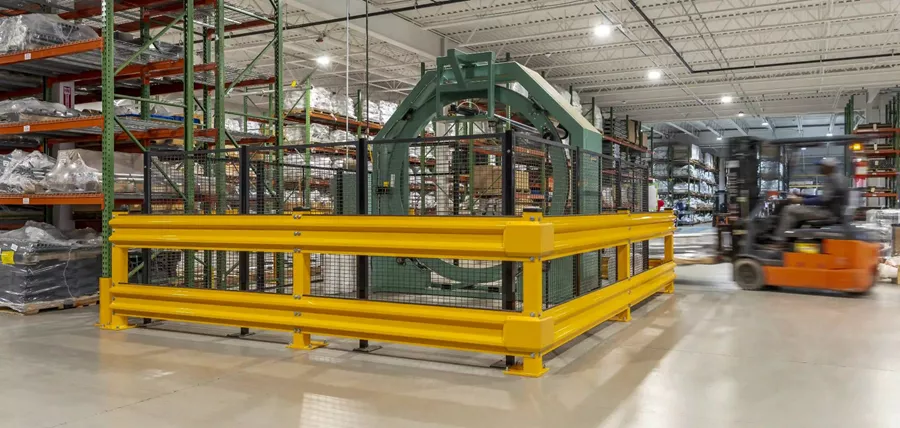
You are visiting the Canada Kee Safety website from United States. Would you like to go to the United States site?
Manufacturing plants produce anything from small OEM parts to large capital equipment. Companies have machinery to build their products. They install HVAC, water, electrical and other systems throughout to run the facility. They invest heavily in inventory and material-handling equipment.
Their greatest asset, however, is their employees. Protecting them from accidents and injury is critical for morale and the business's smooth operation and profitability. Although there are many aspects to safety, here are five solutions for every day and infrequent safety challenges.

Safety railings provide fall protection and traffic control from the lowest to the highest point of an industrial plant. They belong on stairs, mezzanines, loading docks, walkways, around machinery, and on the rooftop.
Pipe-fitted, modular railings are often installed permanently but can also be reconfigured for the changing needs of a plant. Whether aluminum or galvanized steel—both are corrosion resistant—an advantage is that these component-based systems do not require any welding or drilling to put in place.
Safety railing kits offer an effective solution if an extensive railing system is unnecessary, such as guards around a machine or a barrier at a loading area.
For a flat or low-sloped roof, a perimeter railing system that meets regulatory standards will protect workers “collectively.” This means it is always in place and provides rooftop fall protection without the need for special training.
Railings guide traffic and help prevent falls, but when a worker needs to use a stairway, enter the plant floor, go into a restricted area, or reach the roof by a ladder, a self-closing safety gate provides a controlled and safe access point.
For workers that need to load and unload pallets from mezzanines or other elevated working areas, a more extensive “pallet-gate” system will protect people as well as materials.
Workers on a roof often must traverse obstacles (e.g., piping, ductwork). It may be tempting to climb over obstructions; however, a rooftop crossover platform offers a safer, more reliable way to navigate the rooftop. Easily customized, a crossover platform features anti-slip stairs and platforms, plus corrosion-resistant guardrails.
The same concept works within the manufacturing plant to perform work at heights. A work platform can be designed for operators to reach large machinery. A mobile work platform (with locking casters) would be suited to reach warehouse stores or perform vehicle maintenance.

Even a conscientious forklift driver can accidentally collide with racks, a wall, machinery, posts, or just about anything. Traffic protection barriers shield people, machinery, walls, posts, doors, racks, shelves, and other objects from extensive material damage and can help protect the driver.
Forklifts are not the only potential culprits. Dollies and carts can also go astray and cause harm. Traffic protection barriers made of high-grade steel and brightly powder coated reduce the possibility of an accident and minimize damage in case of interior impact.
Often seen on the rooftops of new buildings under construction, warning lines can be used almost anywhere in a facility. Look for systems with solid and durable bases and corrosion-resistant metal uprights connected by vinyl-coated steel cable and marked by large, bright red or yellow flags.
Warning lines can provide permanent rooftop fall protection. However, they must demarcate more than 1.8m from the roof edge. Any work performed should be both infrequent (monthly or quarterly) and temporary (one or two hours on average).
Within the manufacturing facility or the outside grounds, a warning line system is an ideal temporary or permanent marker to cordon off the perimeter of a hazardous area.

Regardless of the building’s age, a modern industrial facility is well-equipped with machinery and equipment to manufacture and ship its products. It has environmental systems that need regular maintenance and repair.
Whether a worker is part of the production or building services team, the person is vulnerable to falls and other potential injury risks. Sometimes, a barrier like a strong railing is needed, but other times, access is required, like a safety gate or platform. With current sensibilities, there is usually a safety solution for every problem.

Long recognized as a leader in rooftop fall protection, Kee Safety has an expanding set of solutions to protect
people inside and outside the facility. Our safety experts bring decades of compliance experience to become
your partner in protecting people from the most dangerous hazards on your site. Focusing on both the welfare
of your people and the profitability of your operation, our tried and tested safety products are built to ensure
consistent performance at the highest level.
Download our Interior Fall and Impact Protection Brochure